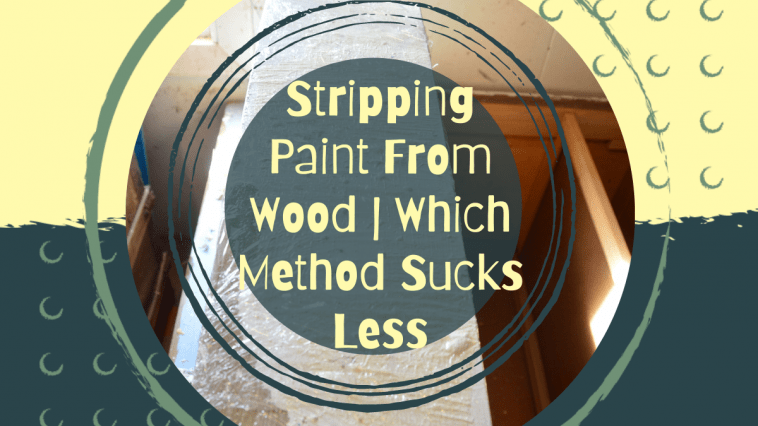
I’m a strong believer in not painting over other paint or finishes on furniture.
The “no-prep” paints nowadays seem to convince people to blindly cover painted furniture with more paint without possibly knowing what’s underneath it!
Learn more about why you should Always Strip & Sand Furniture Before Painting.
But I’ll be the first to admit – Stripping paint from wood sucks! So, I set out to discover: Which method of stripping paint from wood makes it suck a little less??
My research brought me a few methods but honestly, nothing seems too promising. I will go right ahead and say – I’m skipping the “safer” methods for this experiment.
Come to terms with wearing safety equipment while stripping paint.
Please, before trying any of these methods, if using Methylene Chloride or any other super harmful chemical with CAUTION!! & STOP!! marked all over it; listen!
At the very least, you need the following safety gear:
- Thick Safety Gloves (not those thin rubber gloves, the chemicals WILL burn right through them, I learned the hard way) Look for Nitrile Rubber work gloves which are chemical resistant.
- A face mask with a respirator. Not just one for dust and particles, it won’t do anything to stop the fumes. You can find masks that look exactly like those and aren’t crazy expensive, they just have a little box over the mouth area for the respirator.
- Plastic Drop Cloth to protect the area you’re working in.
- Thick Boots
- Long Pants, and Long Sleeves
- Safety Goggles, with sides, to prevent splatter
You’re also going to want a scraper no matter which method you decide to use.
A good 5 in 1 tool is my go-to most of the time for this, as there are many different ways to use it if the piece you’re working on has tight corners or curves.
Otherwise, a sharp putty knife usually works.
As for where to put the paint once it’s off, my favorite technique is using just a piece of cardboard or a cardboard box. Scrape it right onto the cardboard from your putty knife.
When the job’s complete you can put everything you’ve used right in the box with mineral spirits and voila! Safe from spontaneous combustion(never had it happen but it doesn’t sound fun).
7 Methods for Stripping Paint From Wood Furniture
- Paint Stripper + Plastic Wrap Overnight/1 Hour
- Paint Stripper + Plastic Bag
- Heat Gun/Blow Dryer + Scraper
- Torch + Scraper
- Sanding Paint with Orbital Sander
- Paint Removal Attachment on Drill
I tried to find some at-home remedies for paint stripping, but unfortunately, the few that I did find did not seem like the safest options. So I decided not to recommend those to my readers!
Obviously, there’s a reason that strippers are made with such harmful chemicals, if there was a safer at-home remedy I would think they’d have made a product out of it by now!
Basic Paint Stripping with Methylene Chloride Stripper
To start I decided to test out a couple of different brands of Methylene Chloride Stripper with the standard method to show normal results while using it.
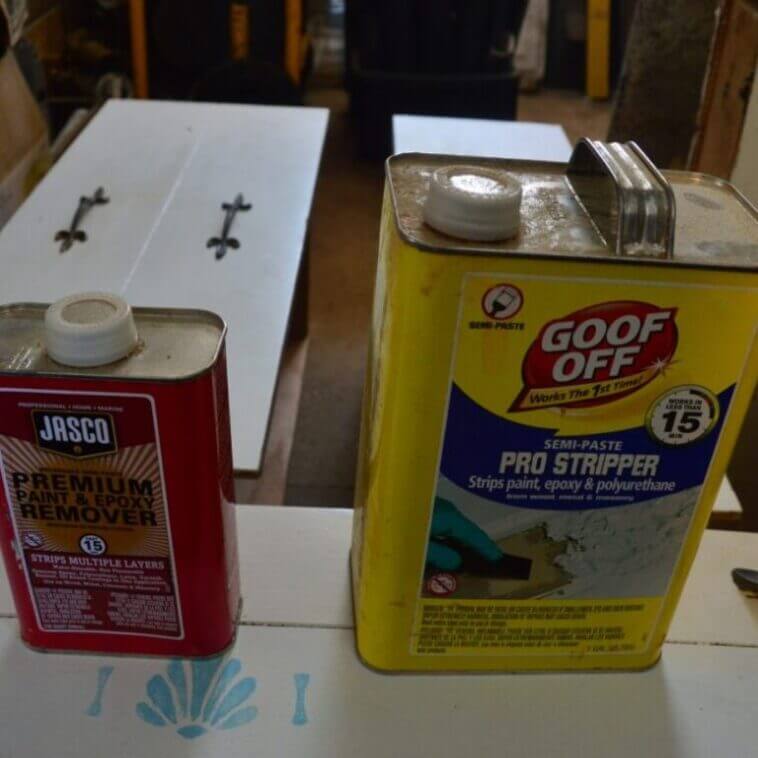
I’m using a Goof Off Semi Paste Pro-Stripper, and Jasco Premium Paint Stripper. I will rate each method against this standard method, and we’ll see how they measure up!
EDIT: Jasco’s stripper no longer has Methylene Chloride! I’ve tested the new formula out, and it works just as well! Also, I don’t believe they make the Goof Off Pro Stripper anymore, so don’t get fooled into purchasing their “pro remover” it does not work for large surfaces, it’s more of a small spot remover.
If you can’t find the Jasco brand stripper, this works great too:
Steps to Strip Paint – Standard Paint Removal Method:
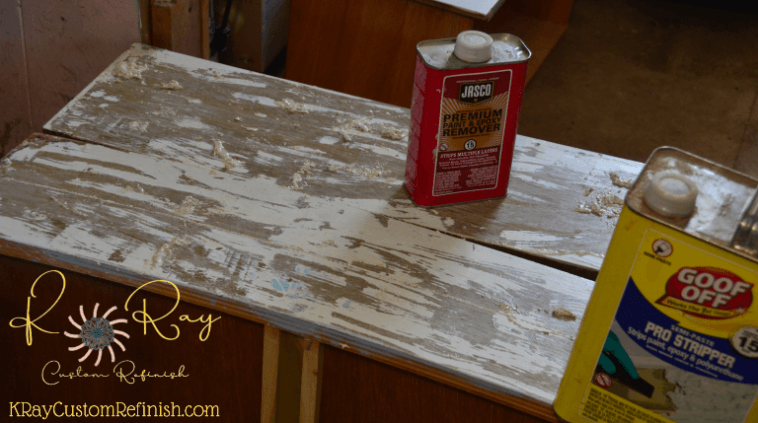
How To Strip Paint From Wood
Prepare your work area
Including plastic on the floor if needed, and a fan for ventilation. Put on your safety gear.
Shake paint stripper well before opening.
You can pour the stripper into a metal container, or just pour straight from the can.
Working in small sections, apply a thick layer of stripper with a paintbrush, or putty knife.
Make sure you apply it in one direction only, don’t brush back and forth. It’s easier to pour a large amount on one end of the piece and then slowly spread it out over the top.
Leave the stripper on for as long as possible.
Check the back of the can for requirements. Usually around 15 minutes.
Use a 5 in 1 tool or putty knife and scrape the paint off.
Be sure to scrape in the direction of the grain.
30 minutes later, wipe down the area with mineral spirits using a piece of 0000 Steel wool.
This should remove any residue of the paint stripper before you move on to refinishing the wood.
Normally, you will need to repeat steps 3-5 a few times to remove all paint.
I was slightly surprised that the Jasco over-performed next to the Goof Off but it just goes to show, the well-known brands are not always the best.
So this method isn’t awful, it strips the paint, doesn’t take a crazy amount of time.
But I would probably need to do it at least one more time to remove everything if I didn’t feel like scraping the hard stuff off or sanding.
Stripping Paint From Wood Method 1: Paint Stripper & Plastic Wrap
I gotta say, this was the method I was most optimistic about.
I found this one during my research a while back after getting frustrated stripping a desk I had been working on for days to no avail.
So I documented it back then, knowing that if it did work I would want to tell people about it!
Basic Steps for Plastic Wrap & Paint Stripper Method:
- Working in small sections, apply a thick layer of paint stripper with a paintbrush, or putty knife.- Make sure you apply it going only in one direction, don’t brush back and forth. So it’s easier to pour a large amount on one end of the piece and then slowly spread it out over the top.
- Cover the entire piece with plastic wrap tightly, and leave it overnight.
- Remove Plastic Wrap
According to others, the paint is supposed to just come right off with the plastic wrap making cleanup a cinch, and no need for scraping.
That did not happen for me.
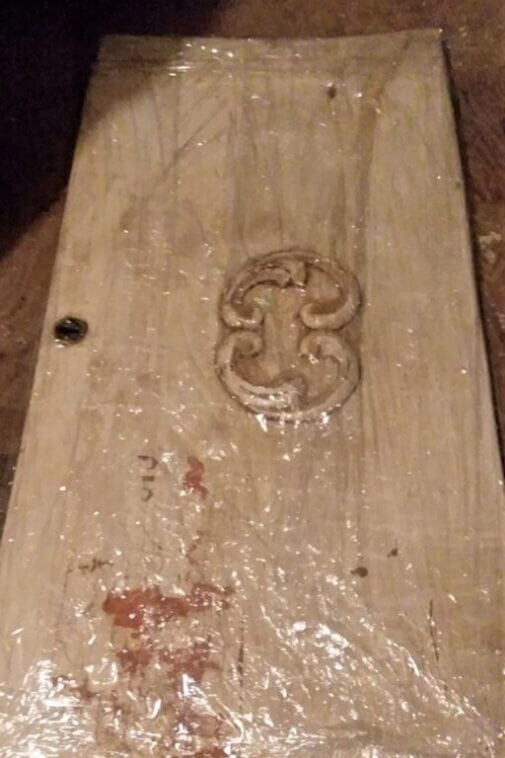
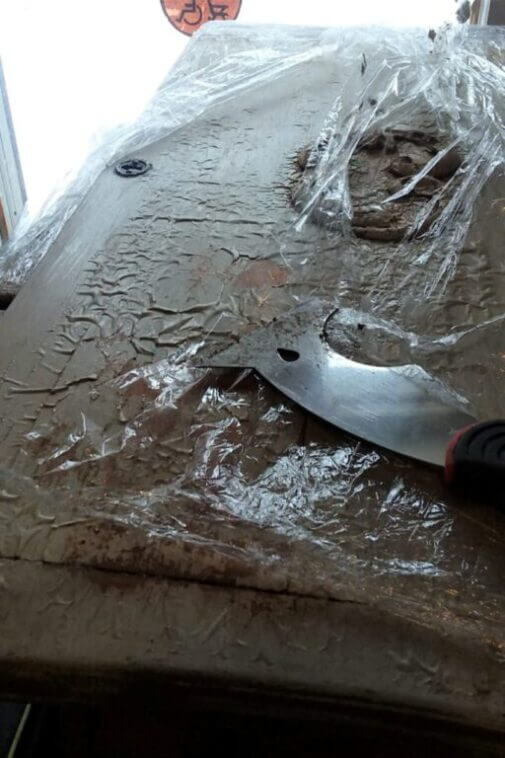
When I removed the plastic, it basically stayed right where it was. You can see the paint bubbled up and probably would’ve been scrape-able had I done it right away.
But because it sat overnight it pretty much hardened over again.
It was impossible to scrape once I removed the plastic wrap. So I ended up doing another coat of stripper and scraping it from there.
The plastic I used is super sticky too in case that’s what you’re wondering…it’s on a roll used for packing packages so “industrial strength” shall we say? And I had the plastic wrap as tight as it could go.
It was touching the wood basically everywhere – although the photos look wrinkled. That’s just the 2nd layer because I wrapped these things a BUNCH!
Rating for Plastic Wrap and Stripper: FAIL!
I had to reapply the stripper and scrape it all over again, so I lost a whole day on the project, used twice as much stripper, annnd a whole bunch of plastic wrap.
It’s really unfortunate because I could see how it SHOULD work, it just didn’t.
Stripping Paint From Wood Method 2: Methylene Chloride and Plastic Wrap for 1 Hour
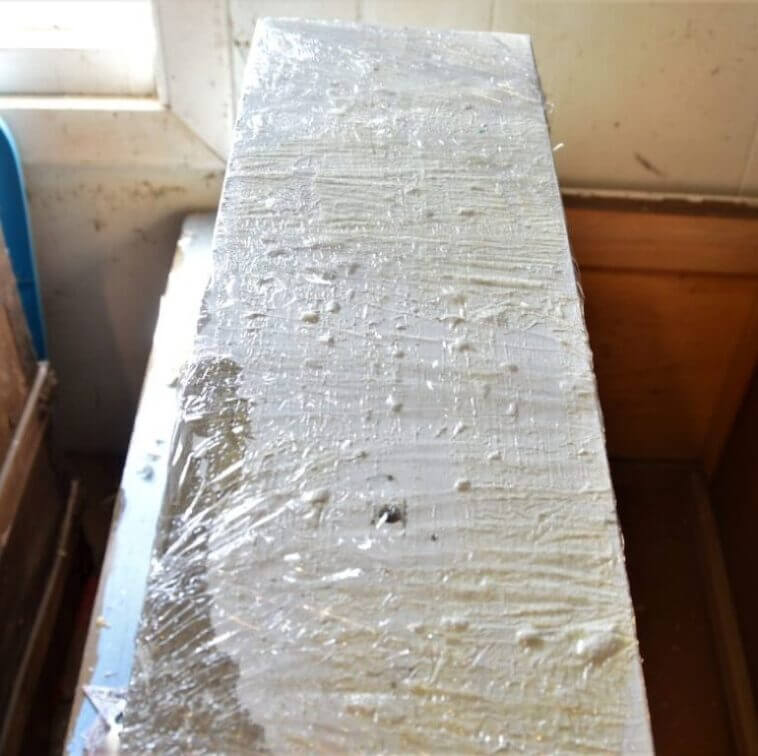
So, I decided to try and give it another go with the plastic wrap, but not leave it overnight this time. I figured maybe overnight was too long and the paint had too much time to re-harden before I removed the plastic.
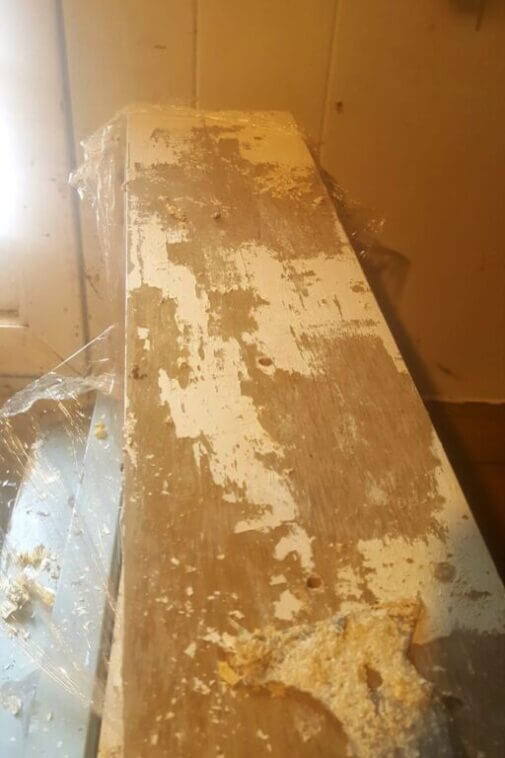
It did work a little better than the overnight method. But still did not do what I’ve seen “advertised” as a quick, “no scrape” method.
I had to scrape it all, and it came off a little easier, but no better than the plain stripper method.
Rating for Stripper and Plastic Wrap 1 Hour: This one would also be lower than just plain stripper, because it takes extra time and effort to wrap everything in the plastic wrap, and we all know how frustrating that alone can be! For not much of a return.
(seriously contemplating trying packing tape on my next experiment)
Stripping Paint From Wood Method 3: Paint Stripper and Plastic Bag
This next one is pretty similar to the plastic wrap, except you put a plastic bag over the piece while the stripper is working. This helps stop the stripper from evaporating, which happens very quickly when it is left out in normal circumstances.
When the stripper starts evaporating, it dries out, the paint starts hardening up again, and you’re left with a bunch of bubbled paint that’s still stuck to the wood!
This is another reason you really want to put a thick layer of stripper on the surface. If not, it really will not do what it’s supposed to.
Below is a video of how well the paint came off after I removed the plastic bag! Not bad!
View this post on Instagram
I was actually very surprised at how well this worked because I really don’t see a huge difference in this and the plastic wrap, but Wowza did it work better.
My plastic bag wasn’t big enough to completely cover the drawer, which really, more often than not, you probably won’t be able to cover a piece of furniture with a bag either.
So just place it over the area with the stripper, and make sure no air can get in or out.
Stripping Paint From Wood Method 4: Blow Dryer & Scraper
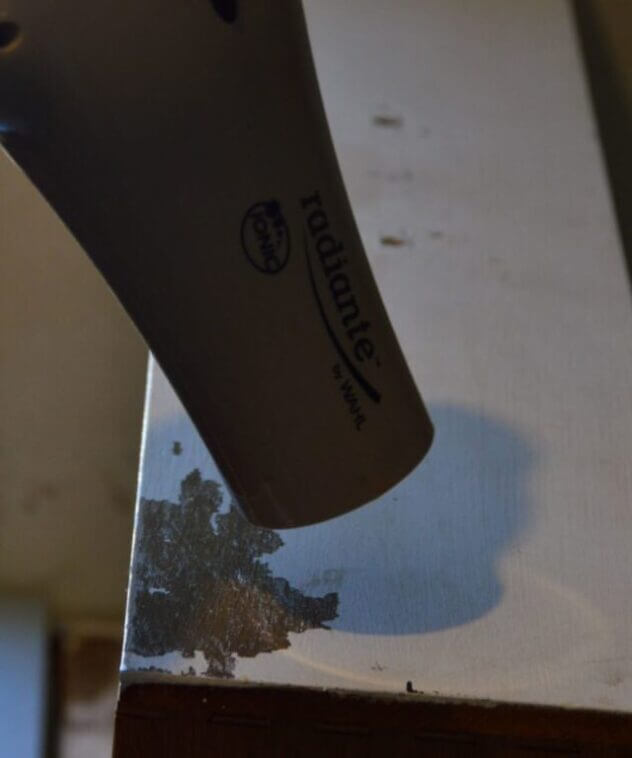
This method I won’t get too far into, it doesn’t work well. It did not heat the paint up enough to really matter.
I might as well have just been scraping the paint off with no pre-treatment. I don’t have a heat gun, but have used them before, and know it wouldn’t be much different with one.
Rating: Not a great option, heat gun would work better, but would still take quite a while.
Stripping Paint From Wood Method 5: Torch & Scraper
This method worked much better than the blow dryer, but I can definitely see it being risky.
If you leave the torch on one spot for too long, it WILL catch your piece on fire. You still need to scrape the paint, but it definitely goes a little faster.
There is a high chance of damaging the piece though so proceed with caution.
Stripping Paint From Wood Method 6: Orbital Sander
This paint stripping method I have done quite a few times. If you hate sanding as many people do….it’s pretty much double the sanding.
If you don’t mind it, then no big deal! I, for one, enjoy sanding. But after sanding the paint off a piece, and then sanding the wood down to smooth, even I can say it gets old.
Rating: I wouldn’t recommend it for large pieces, with multiple layers of paint. But a quick small side table with one layer of paint is a cinch! Just be sure to check for lead paint before doing it, and wear a mask for sure!!
Stripping Paint From Wood Method 7: Paint & Rust Stripper Attachment on Drill
Some of you may not know what I’m talking about when I say that. Here is a photo:

It’s a neat little attachment, made of a Scotch-Brite abrasive web, that is not sharp or scratchy.
It does remove paint quickly, but there’s always a chance of gouging the wood underneath.
The dresser I’ve been using to experiment on for this has veneer on it, which I plan to remove anyway. Since this is my first time using one of these, I definitely took it down to the wood on a few spots:
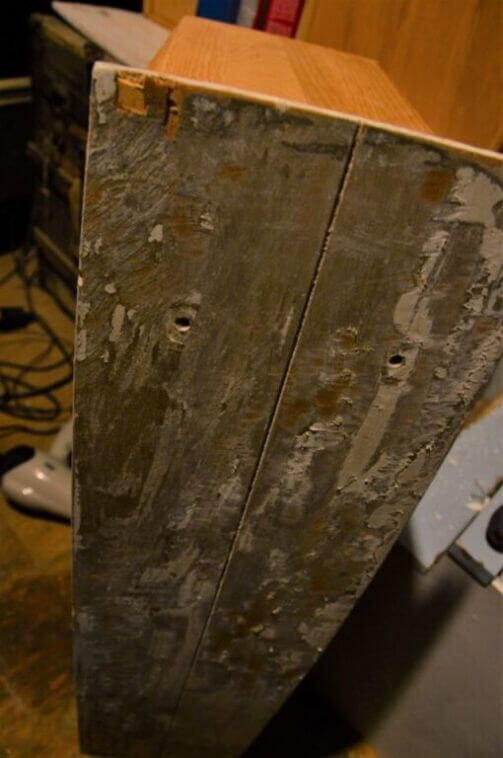
So you need to be very careful using it.
You can use the edge of it, or the face of it. I found that the edge worked faster.
But either way, I love it! I stripped a drawer in about 5 minutes. It takes some getting used to but I really recommend it. Especially if the piece you’re working on has multiple layers of paint to remove.
They don’t cost much either:
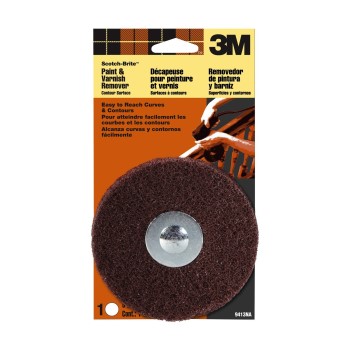 3M 051144094134 Sanding Disc Pad, Paint/Varnish Remover ~ 5″ – $6.31 Sanding Disc Pad, Paint/Varnish Remover ~ 5″ |
I could’ve probably done my whole dresser with just this one pad if it had been brand new when I tried it.
Rating: I’d say it’s a good choice if you have a decent drill. Just definitely practice on something else before using it on a piece you care about.
If the piece has multiple layers of paint, you’re less likely to get down to wood too quickly.
EDIT: I recently found these discs which are specially made for flat surfaces.
They don’t have that little annoying metal piece in the center on the flat side, so you can use the face of it without scratching the wood, and it works amazingly well!
Related: Best of List Part 1: Tools & Supplies For Refinishing Furniture
EDIT: Since writing this post I’ve found a new tool that incorporates something similar to the Paint Stripping Attachment.
This is my new #1 choice for Stripping paint from wood! Check out my post on The Best Sander for Stripping Furniture.
So that pretty much sums it up, I tested all methods and I’m confident that I can answer the question:
Which Method of Stripping Paint from Wood Sucks the Least?
1 – Jasco Paint Stripper & Plastic Bag
– apply stripper following the instructions on the can. Cover the entire piece with a large plastic bag immediately after applying. Remove and scrape loosened paint with a putty knife after the recommended wait time.
And the rest of the options in order from best to worst:
2 – Paint Stripper Drill Attachment
3 – Orbital Sander
4 – Torch and Scraper
5 – Plastic Wrap and Paint Stripper 1 Hour
6 – Plastic Wrap and Paint Stripper Overnight
7 – Blow Dryer/Heat Gun and Scraper
What do you think? Am I missing any secret stripping paint methods that you’ve tried?
I’m always willing to try any method that might make stripping paint just a little less sucky!
After you have the paint removal taken care of, head over to my posts Tips for Sanding Wood Furniture, and How To Stain Wood Furniture – FAQs Answered to complete your piece the right way.
My DIY Resources Page also has tons of helpful cheat sheets, product recommendations, and much more to assist you on your next furniture restoration project. Check it out!
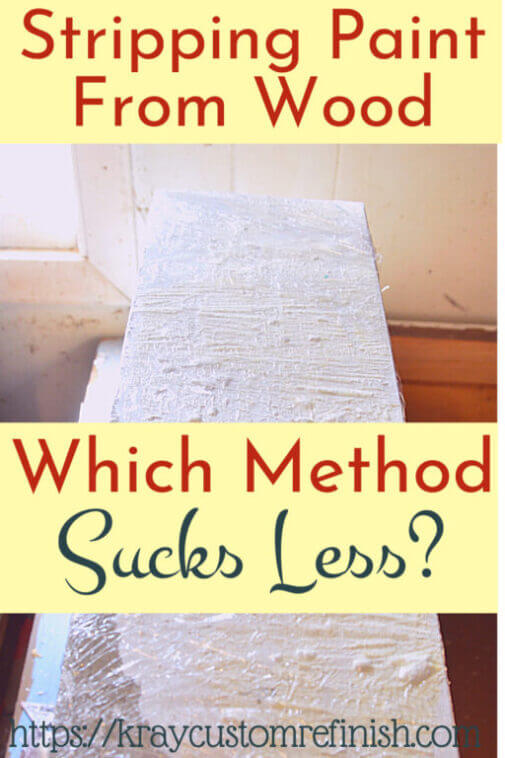
Until Next Time,
KRay

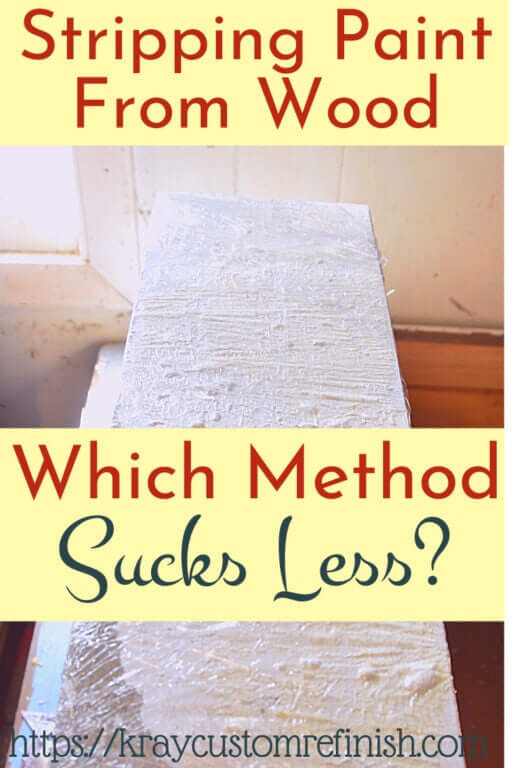

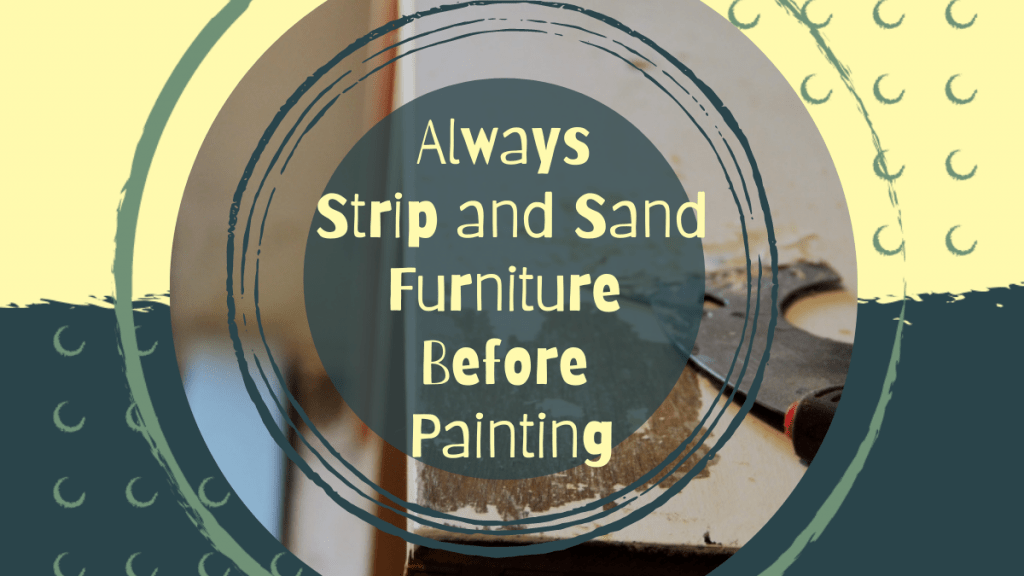
Aw, this was an extremely nice post. Spending some time and actual effort to produce a great article… but what can I say… I hesitate a whole lot and never manage to get nearly anything done.
Thank you for your kind comment! I do it so you don’t have to! 🙂
Hey there, I think your site might be having browser compatibility
issues. When I look at your blog site in Opera, it looks fine but when opening in Internet Explorer,
it has some overlapping. I just wanted to give you a quick heads up!
Other then that, amazing blog!
Old post but for what it’s worth…
The plastic wrap overnight works really well with metal and stone substrates but wood absorbs all the moisture overnight so it dries out from the inside. I’m playing around with soda blasting but it’s not a surefire solution. Tends to remove paint AND some of the wood.
Thank you so much, I am thinking about doing an updated one of these because there are a few new options out there since I wrote this. Very good to know though about the plastic wrap and soda blasting I wanted to try that too! thank you!
Hello! This is my first comment here so I just wanted to give a quick shout out
and tell you I genuinely enjoy reading your articles.
Can you suggest any other blogs/websites/forums that go over the same subjects?
Thank you!
Thank you so much for the great article, it was fluent and to the point. Cheers.